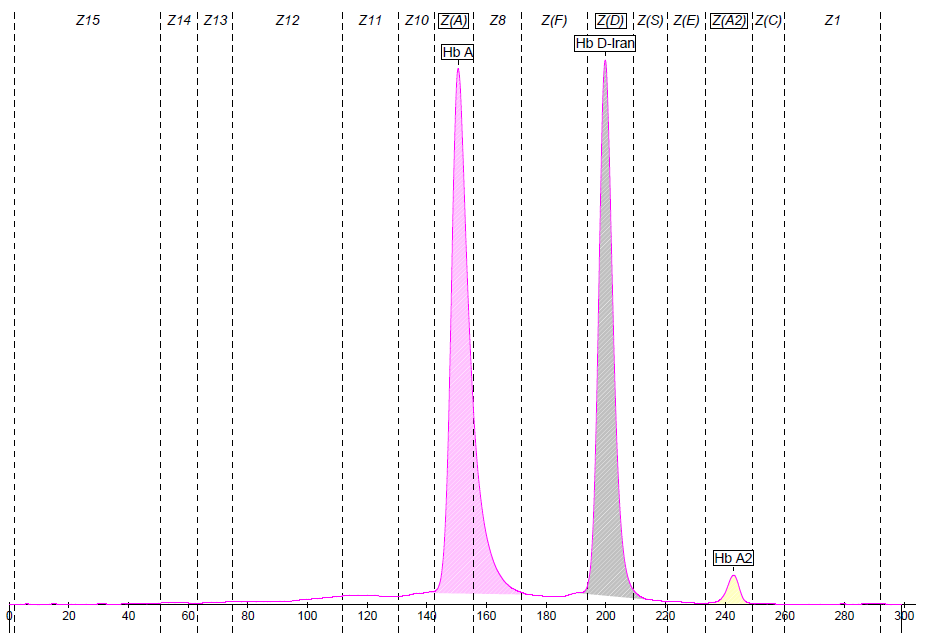General information
Globin chain involved
Status
Heterozygous
Migration zones
Migration positions
200
Sickle Cell Disease: No
Thalassemic variant: No
Capillary Electrophoresis
Fractions
Value %
Hb A
55.2
Hb D-Iran
42.9
Hb A2
1.9
Comments
In the presence of Hb D-Iran, the percentage of Hb A2 is generally slightly decreased, just below 2.0%.
Mutation data
Heterozygous Hb D-Iran
Mutation
HGVS Nomenclature
Beta 22(B4) Glu>Gln
HBB:c.67G>C
Hematological parameters
Name
Result
RBC Count
Normal
Total Hemoglobin
Normal
MCV
Low
MCH
Normal
Blood smear
Normal
Other analysis
No information
Comments on hematology
Normal
Clinical context
Clinical presentation
Normal
Clinical risk
No data
Variant information
Stability
Normal
Oxygen affinity
Normal
Ethnicities in literature
Found in Asian, Black African & Caucasian populations: met in several Iranian families, in a 25-year-old Pakistani female and relatives, in some Indian families, in a Jamaican Black newborn of West African ancestry living in the US, in some Algerian & Turkish families, and some families in Northern Calabria, Italy
Comments on variant information
The rare variant Hb D-Iran has been found in combination with Hb S (benign Sickle Cell Syndrome), Hb D-Punjab, Beta0-thalassemia (619 bp deletion), Beta0-thalassemia IVS1-5 (G>C), Beta0-thalassemia [cds 41/42 (-CTTT)], and also in homozygous state.
Scientific Literature
Scientific references
- https://pubmed.ncbi.nlm.nih.gov/4715135/ Rahbar S., Br J Haematol. 1973 Jan;24(1):31-5.
- https://pubmed.ncbi.nlm.nih.gov/4725603/ Rohe RA. et al., Blood. 1973 Sep;42(3):455-62.
- https://pubmed.ncbi.nlm.nih.gov/7073867/ Serjeant B. et al., Hemoglobin. 1982;6(1):57-9.
- https://pubmed.ncbi.nlm.nih.gov/8195010/ De Marco EV. et al., Hemoglobin. 1994 Jan;18(1):65-9.
- https://pubmed.ncbi.nlm.nih.gov/11196276/ Thornburg CD. et al., J Pediatr Hematol Oncol. 2001 Jan;23(1):67-8.
- https://pubmed.ncbi.nlm.nih.gov/25332633/ Gupta A. et al., Indian J Hematol Blood Transfus. 2014 Sep;30(Suppl 1):409-12.
- https://pubmed.ncbi.nlm.nih.gov/26393119/ Chandel RS. et al., J Clin Diagn Res. 2015 Jul;9(7):BD01-2.
Globin Chain involved
Status
The term "Double Heterozygous" refers to cases of heterozygosity on different globin chain types, while the term "Compound Heterozygous" refers to cases of heterozygosity on the same globin chain type.
For example, S/G-Pest is a Double Heterozygous case (beta and alpha-globin chains are mutated) and S/C is a Compound Heterozygous case (only beta-globin chains are mutated).
Migration zones
Migration positions
Sickle Cell Disease
Thalassemic variant
Capillary Electrophoresis
Variant information
Ethnicities are provided for informational purposes only and are based on scientific literature and conference posters.
A hemoglobin variant may therefore be present in populations of ethnic origins or countries not listed here.

